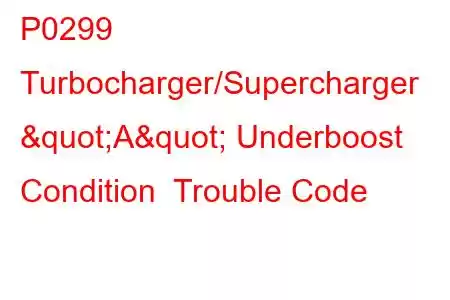P0299 Turbocharger/Supercharger A Underboost Condition
OBD-II Trouble Code Technical Description
Turbocharger/Supercharger A Underboost Condition
What does that mean?
This diagnostic trouble code (DTC) is a generic powertrain code, which means that it applies to OBD-II equipped vehicles that have a turbocharger or supercharger. Brands of vehicles affected may include but are not limited to Ford, GMC, Chevy, VW, Audi, Dodge, Hyundai, BMW, Mercedes-Benz, Ram, Fiat, etc. Although generic, the specific repair steps may vary depending on make/model.
The P0299 DTC code refers to a condition where the PCM/ECM (powertrain/engine control module) has detected that the bank "A" or single turbocharger or supercharger is not providing a normal amount of boost (pressure).
That could be due to a variety of reasons, which we detail below. On a normally operating turbocharged or supercharged engine the air going into the engine is pressurized and that's part of what makes so much power for an engine of it's size. If this code is set, you will likely notice reduced power output. Turbochargers are driven from the exhaust exiting the engine to use a turbine to force air into the intake. Superchargers are mounted on the intake side of the engine and are typically belt driven to force more air into the intake, with no connection to the exhaust.
In the case of Ford vehicles, this may apply: "The PCM checks for a minimum throttle intake pressure (TIP) PID reading during engine operation, which indicates an underboost condition. This DTC sets when the PCM detects that the actual throttle intake pressure is less than the desired throttle intake pressure by 4 psi or more for 5 seconds."
In the case of VW & Audi vehicles, the code definition is slightly different, it is "Boost Pressure Regulation: Control Range Not Reached." As you can probably tell that's basically just another way of stating an underboost condition.
A typical turbocharger and related components:
Severity
The severity of this code can vary from moderate to severe. If you delay repair of this issue, you can potentially experience more extensive and costly damage.
Symptoms
Symptoms of a P0299 DTC may include:
MIL (Malfunction indicator lamp) illumination Reduced power output from engine, possibly in a "limp" mode Unusual sounds from the engine/turboThere would likely be no other symptoms.
Potential Causes
Potential causes of a P0299 turbo underboost code include:
Intake (induction) air restriction or leak Failed or damaged turbocharger (sticking, binding, etc.) Faulty boost/charge pressure sensor Faulty wastegate bypass regulator valve (VW) Low fuel pressure condition (Isuzu) Sticking turbo nozzle control solenoid (Isuzu) Faulty injector control pressure (ICP) sensor (Ford) Low oil pressure (Ford) EGR system fault (Ford) Variable geometry turbocharger (VGT) actuator (Ford) VGT vanes sticking (Ford)Possible P0299 Solutions
First off, you'll want to repair any other DTC codes if present prior to diagnosing this code. You will next want to search for Technical Service Bulletins (TSBs) that may apply to your year/make/model/engine configuration. TSBs are bulletins put out by the auto manufacturer to provide information on known issues, commonly surround specific trouble codes like this. If there is a known TSB you should start with that diagnosis as it can save you time and money.
Start with a visual inspection. Inspect the intake air system for cracks, loose or disconnected hoses, restrictions, blockages, etc. Repair or replace as required.
Check the turbocharger wastegate regulating valve solenoid for correct operation.
If the air induction system tests OK, then you'll want to focus your diagnosis efforts on the charge pressure control, diverter valve (blowoff valve), sensors,
Read: 52


